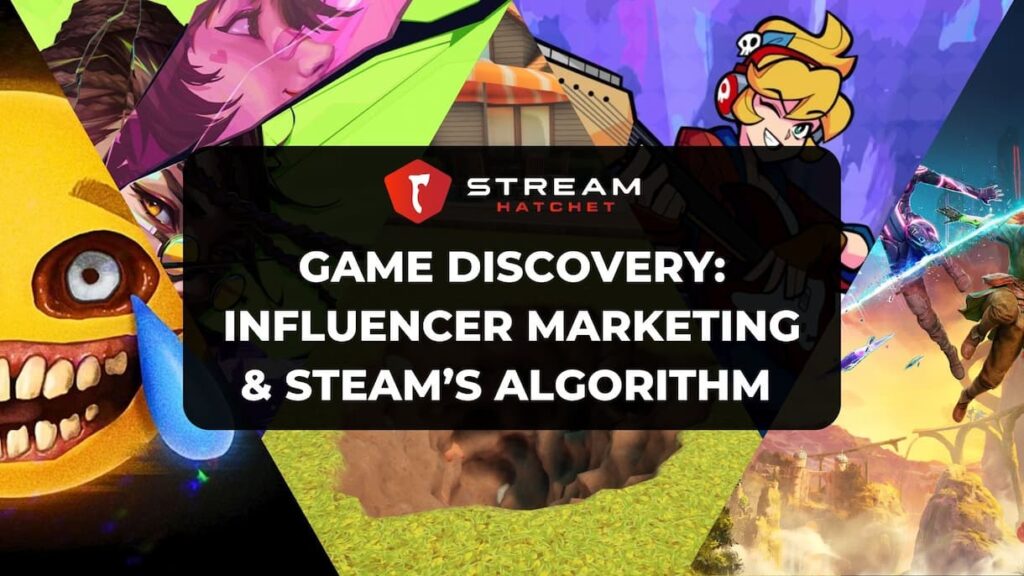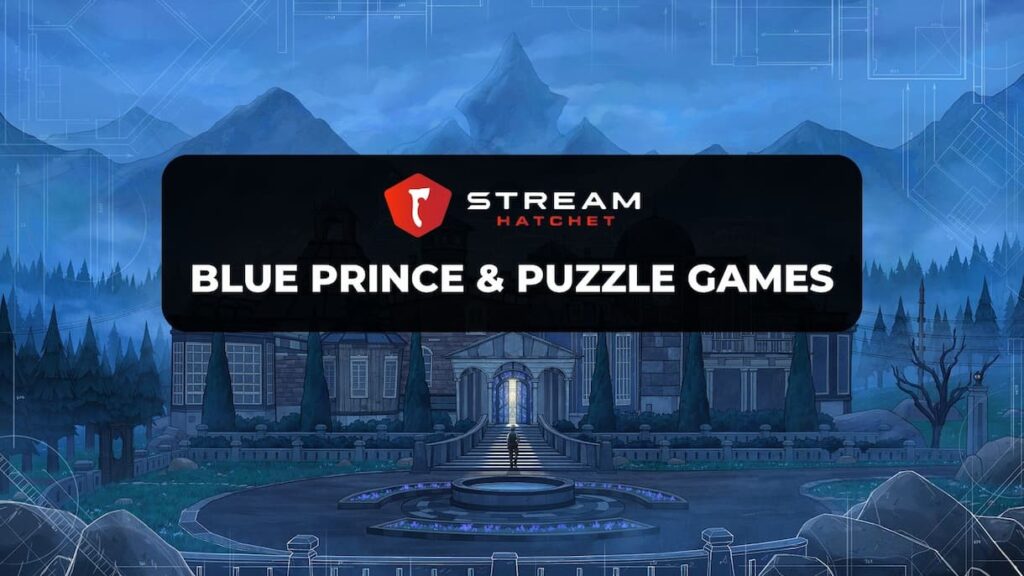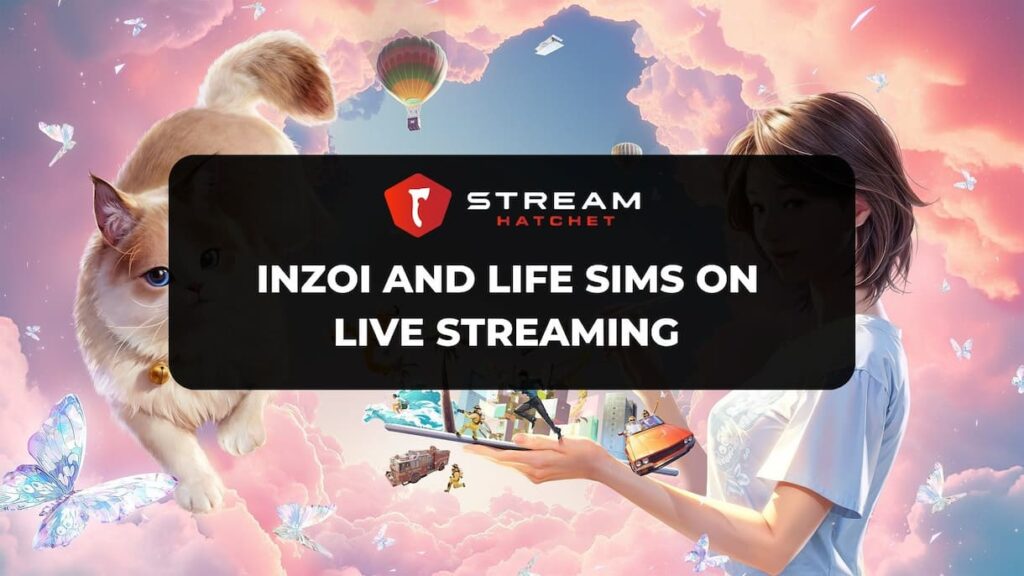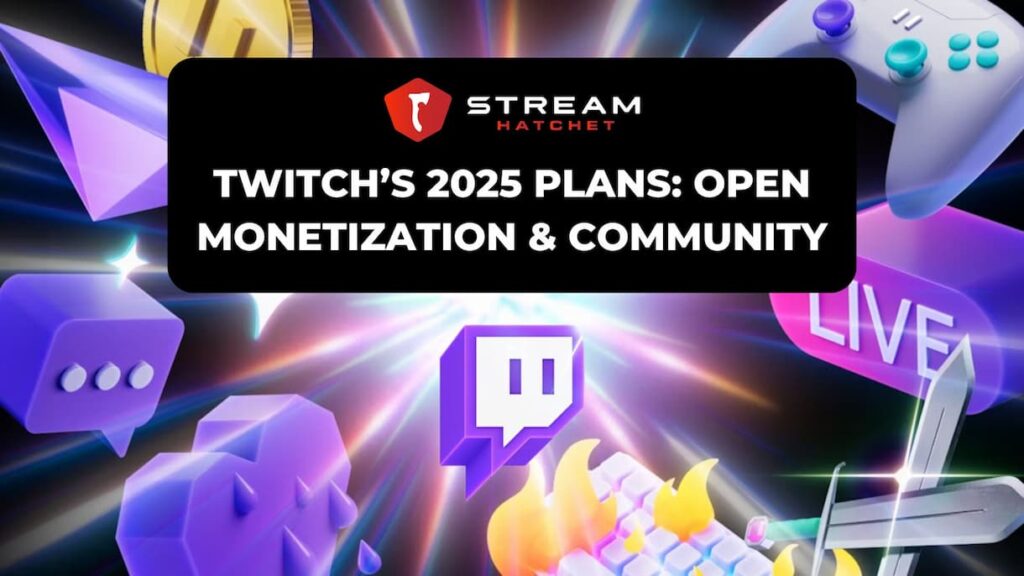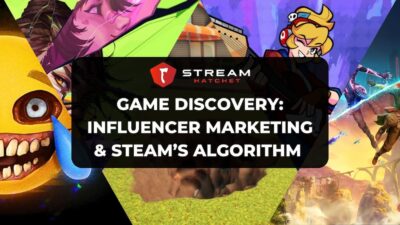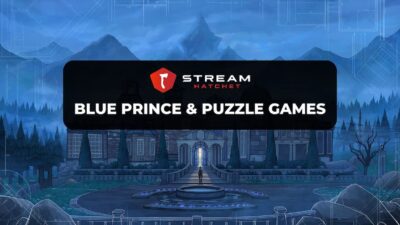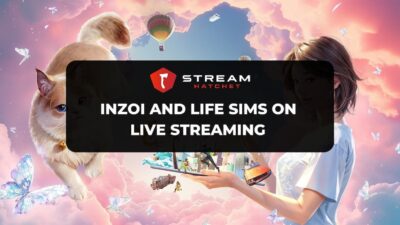Standing out among the crowded PC gaming shelves seems nigh on impossible in an age where over 15K games are released every year on Steam. Indie developers in particular are hard-put to get their games in front of players, participating in loaded events like Steam Next Fest or IRL conventions like GDC to meet players halfway. Since around 2016, the go-to method for catching gamers’ attention was influencer marketing: Sponsoring big-name streamers who can vouch for the quality of your title and preview the game to their fans.
But the winds are changing according to game marketing experts like Ryan K. Rigney, who points out that paid influencer marketing campaigns nowadays have “awful conversion rates”. The Golden Age when streamers like Ninja could single-handedly propel games like Apex Legends to global success may be over, with viewers supposedly becoming inured to ads from their favourite streamers. But does that spell doom for influencer marketing initiatives? Should developers and publishers be so quick to move their attention from influencers to Steam page metrics? Let’s take a look at the current state of game marketing through the lens of recent indie game releases.
The Current Meta of Game Marketing: Influencers Vs. The Steam Algorithm
The stats seem to suggest that indie developers should be focusing most of their attention on gaming the Steam algorithm. According to game marketing consultant Chriz Zukowski, for “most games, when they launch, 50% of the traffic comes from the Discovery Queue” on Steam. In other words, players find out about new titles when the algorithm says ‘this is like other games you liked’ (due to genre, aesthetic, audience overlap, etc.). This is true: Steam’s algorithm has an uncanny ability to create personalized recommendations. But this point misses out on the power of influencers in getting your game onto that Discovery Queue in the first place.
A solid approach to modern-day indie game marketing is summarized well by Matt Hackett over at Valadria: Create a great game, dress it up in nice packaging, then get it in front of influencers. He understands that influencer marketing is important because influencers have a magnifying effect: If your game catches just one influencer’s interest, they’ll share it with their entire fanbase. Crucially, the game should TRULY resonate with the streamer to earn a genuine recommendation and ignite the kind of passion that viewers gravitate towards. Without big IP or industry cred from previously shipped titles, indies need custom support from popular early adopters.
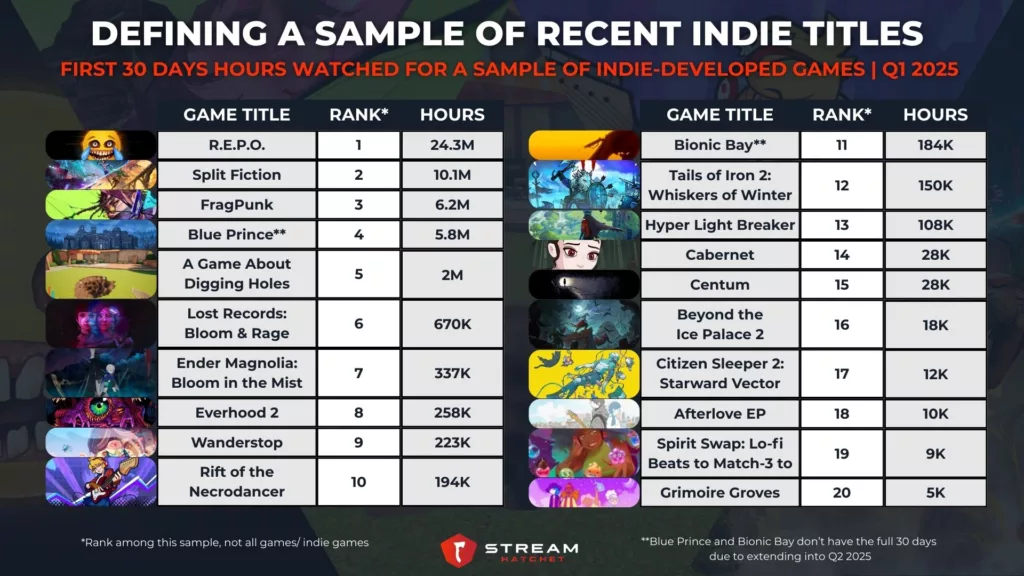
To back this idea up, we’re going to look at hours watched in the first 30 days for 20 games released by indie developers during Q1 2025 to see how different approaches to influencer marketing have created awareness for the game on live-streaming platforms. Keep in mind this is just a sample, and there is significant variation between the size of the games’ publishers (e.g., FragPunk is backed by NetEase) and the games’ statuses as either originals or backed by pre-existing IP (e.g., Rift of the Necrodancer). Additionally, two games (Blue Prince and Bionic Bay) have incomplete data due to stretching into Q2 2025. For ease of comparison across vastly different metrics, we’ll use a log10 scale on all metrics across the following scatterplots. In other words, we’re dealing with orders of magnitude here – keep that in mind.
A Narrow Influencer Marketing Approach: Targeting Top Streamers

The first idea we’re looking at harkens back to that aforementioned Golden Age concept where just one or two big-name streamers covering your game can drive its popularity into the stratosphere. Of the 20 games examined, just 8 were played by Top 100 streamers, but these 8 games outperformed nearly every other game in the sample (we’ll cover those in a moment). Within this sample, there’s a strong correlation between more hours watched on streams by the top 100 streamers and total hours watched on the platform. This makes sense since the former metric adds to the latter metric, but there’s also likely a copycat effect here whereby smaller streamers see bigger streamers covering these games and want to hop on the trend.
Among the 12 games not played by the Top 100 streamers, however, there’s still significant variation in success. 3 of the non-Top 100 games competed with the previous grouping (Lost Records: Bloom & Rage, Ender Magnolia: Bloom in the Mist, and Everhood 2), and the top game in this grouping (Lost Records: Bloom & Rage) had viewership 2 magnitudes higher than the lowest game in this grouping (Grimoire Groves). It seems, then, that hitting those big streamers certainly isn’t a necessity for success, but phenomenal success for original IP requires their attention (e.g. R.E.P.O., Blue Prince). The team behind SUPERVIVE has adopted this narrow approach to influencer marketing, performing pre-release playtesting with notable streamers like Caedrel and Tyler1 to build their bond with the game.
A Wide Influencer Marketing Approach: Creating Multiple Sponsored Streamers
While the narrow approach can hit big, it’s also a massive gamble of a studio’s time and effort: What if they try to nurture this big-name streamer, only for them to just not click with the game? Or maybe they have conflicting responsibilities with a major esports tournament right when you want to launch the title? Or, the most frustrating of all, they become embroiled in a personal controversy and fall out of favour with viewers? It’s like putting all your eggs in one basket. For this reason, many studios are gravitating towards a wide approach to influencer marketing, where they reach out to numerous streamers with different audiences so they can hedge their bets.
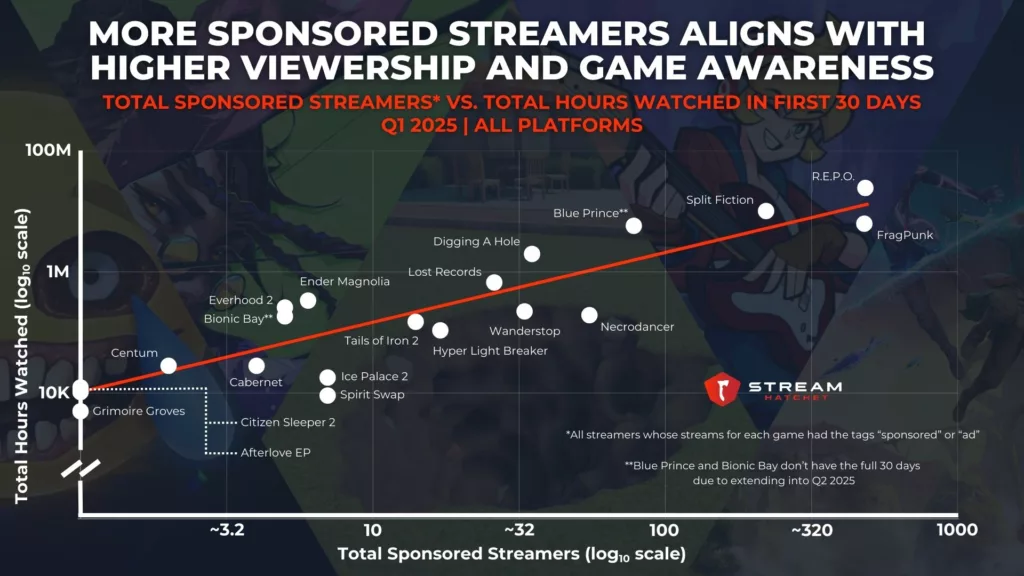
Does this ‘shotgun strategy’ work? The data suggests so: When looking at the total number of sponsored streamers covering the sampled games in their first 30 days (regardless of audience size) against the games’ total hours watched over the same period, there’s again a strong correlation. Keep in mind that this only looks at 30 days post-release, and ignores sponsored streams for events prior to release like betas and demos. For example, Blue Prince had no sponsored streams by the Top 100 streamers after release, but the game’s demo had a sponsored stream by CohhCarnage during Steam Next Fest last year – and he went on to play the game upon release out of pure adoration.
How does this data relate to those all-important Top 100 streamers, though? Across all 20 games examined, almost none of the sponsored streamers were from the Top 100, suggesting that getting big-name streamers isn’t essential for this wide approach to work (the exceptions being FragPunk with 8 Top 100 streamers, and Split Fiction and Wanderstop with 1 Top 100 streamer each). Still, if you do want their attention, sponsorship is highly recommended: Only 4 games brought in viewership from the Top 100 streamers despite having no sponsors among that group: R.E.P.O., Blue Prince, A Game About Digging A Hole, and Rift of the Necrodancer. R.E.P.O. and A Game About Digging A Hole are unique examples of original indie games becoming live-streaming hits Top 100 streamers riding the wave of hype (rather than starting the wave themselves).
A Creative Influencer Marketing Approach: Running Live-Streaming Events
Of course, live streaming offers more opportunities for promoting one’s game than simple endorsements. Engaging with the live-streaming community in creative ways unique to these platforms is essential for fostering collaboration and communication between fans. Here, we look at the number of streamers participating in “Drops” events, of which there are two main kinds: The traditional Twitch Drops (viewers that tune-in receive in-game loot), and the more innovative Dare Drops (participating streamers who complete certain challenges receive in-game loot which they can then gift to their fans).
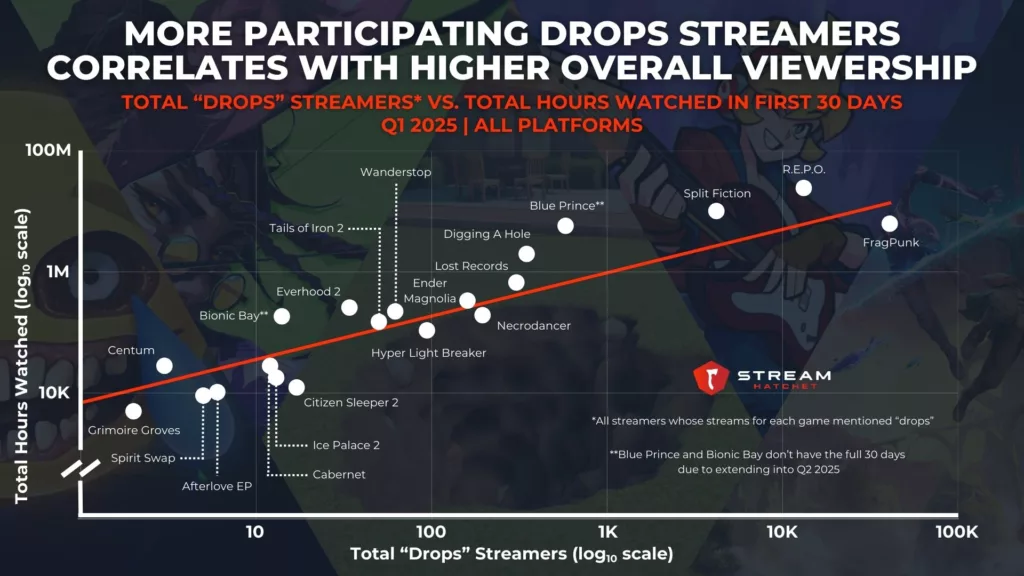
As expected, there’s a close relationship between the number of streamers participating in Drops events and the total hours watched of the game on live streaming. 3 of the 20 games sampled had massive numbers of Drops streamers: FragPunk, Split Fiction, and R.E.P.O.. Live service games like FragPunk are particularly well-suited to Twitch Drops events, fostering ongoing engagement from the community with easily updated rewards per season. Dare Drops, on the other hand, offer an exciting opportunity for games with high skill ceilings but limited campaign modes. Rift of the Necrodancer, for example, used Dare Drops to challenge players to show off their rhythm skills in a way similar to the Guitar Hero 3 tournaments of yore.
_
So far, we’ve shown that actively investing in influencer marketing initiatives strongly correlates with increased viewership – but we acknowledge there are many confounding factors here. To name just one, games that put more money into influencer marketing are also likely to have bigger budgets for other marketing forms as well (e.g., FragPunk or Split Fiction). No doubt the attention on these games is a combination of strategies. But, crucially, influencer marketing has key synergies with these other strategies. The much-touted Steam algorithm still relies on an initial human interest to spark off curiosity, and this is where influencer marketing excels over other paid advertising.
For that reason, indie developers should consider how narrow, wide, or creative approaches to influencer marketing best suit their individual needs, and naturally, which streamers would make the best partners for their game. While it’s true that throwing money at a well-regarded influencer doesn’t guarantee success, genuine relationships with streamers that are mutually enjoyable will lead to more viewership and, hence, more awareness. One could fairly question whether more live-streaming awareness necessarily translates to actual conversions, however, which is why we’ll be tackling this question in an upcoming blog. For now, suffice to say that influencer marketing remains a linchpin in any successful game launch.
To keep up to date with the influencer marketing meta, follow Stream Hatchet:
